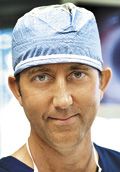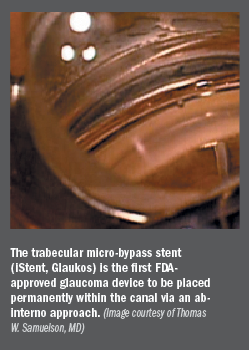Article
New surgical options help individualize glaucoma care
Recent advances in surgical therapeutic modalities are enabling ophthalmologists to provide individualized care for their patients with glaucoma.
Listen to Thomas W. Samuelson, MD, present The David Worthen Memorial Lecture during the Current Concepts in Ophthalmology meeting at the Wilmer Eye Institute/Johns Hopkins University. Dr. Samuelson's presentation is entitled "Individualizing Glaucoma Surgery."
Take-home
Recent advances in surgical therapeutic modalities are enabling ophthalmologists to provide individualized care for their patients with glaucoma.

Dr. Samuelson
By Liz Meszaros; Reviewed by Thomas W. Samuelson, MD
Minneapolis-Advances in surgical therapeutic modalities for glaucoma are giving surgeons more options for more individualized treatment, said Thomas W. Samuelson, MD.
Traditionally, glaucoma treatment has included medicine, laser, trabeculectomy, and trans-scleral procedures, said Dr. Samuelson, founding partner and attending surgeon of Minnesota Eye Consultants, Minneapolis.
Yet, this wide spectrum of treatments also involves a wide spectrum of risks, he noted.
“We know well what to do surgically for patients with severe disease,” Dr. Samuelson said. “However, what do [we do] surgically with uncontrolled mild-to moderate disease?
“We can watch [patients’ disease] get worse as we add a third and fourth medication,” he said. “We can offer them surgery. But if we do so, we have to take good care to make sure that our surgical risk doesn’t outweigh our disease risk.”
With time and research, newer options are finally becoming available.
“Finally, we’re seeing investment in surgical glaucoma,” Dr. Samuelson said. “If we’re under-invested in glaucoma, it is not in drug therapy, it is not in diagnostics; it is in the surgical therapeutic modalities or neurodegenerative/neuroprotective treatments.”
Weighing the risks
Over the years, highly efficacious procedures for the treatment of glaucoma have been available. Yet, according to Dr. Samuelson, they may entail significant risk, which leads to a very large safety gap for patients. That is, there is a huge gap in safety between medicines and lasers on one hand, and trabeculectomy and tubes on the other hand.
“Many would argue that the safety of tubes and trabs is far less than desired, but no one would argue their efficacy for the most part,” he said. “What we haven’t had are procedures that err on the side of safety. Tubes and trabs are highly efficacious, but they are considerably less than safe.”
For decades, ophthalmology has applied these procedures across this spectrum of glaucoma severity, he continued. If a patient’s response to medical and laser therapy failed then we tended to advance toward trabeculectomy.
“But the risk of functional impairment among individuals is highly variable,” Dr. Samuelson said. “There is somewhat of a mismatch. There’s a wide spectrum of risk, but until now we have not had a wide spectrum of procedures.”
Megatrends in glaucoma surgery
With the advent of microinvasive glaucoma surgery (MIGS), these risks are perhaps being mitigated, Dr. Samuelson continued.
“We’re seeing a lot of discussion about MIGS filling the safety gap between trabeculectomy and medical therapy,” he said. “We’re also standardizing filtration surgery even more, and we are trying to individualize care.”
MIGS currently includes a variety of new instruments and techniques that are rapidly evolving in the hands of ophthalmic surgeons.
FDA-approved MIGS devices include:
- Ex-Press Glaucoma Filtration Device (Alcon Laboratories).
- AqueSys Implant (AqueSys).
- iStent Trabecular Micro-Bypass Stent (Glaukos Corp.).
- Trabectome (NeoMedix Corp.).
- CyPass Micro-Stent (Transcend Medical).
“In glaucoma surgery 2013, we had far more options to offer patients, all with varying degrees of efficacy and risk,” Dr. Samuelson said. “Our goal is to match surgical risks with the risk of the disease. MIGS helps fill that safety gap; it’s not for everyone, but it is for some patients for sure.”

Data for Trabecular Micro-Bypass Stent
Dr. Samuelson led a prospective randomized clinical trial-the first and most comprehensive PMA, IDE trial for a glaucoma therapeutic device-in which he and his colleagues compared results cataract surgery alone with results achieved with cataract surgery plus the trabecular micro-bypass stent, a small device placed in Schlemm’s canal.1
In all, 240 eyes with mild-to-moderate open-angle glaucoma with IOP of ≤ 24 mm Hg controlled on 1 to 3 medications were randomly assigned to undergo cataract surgery with implantation of the trabecular micro-bypass stent (treatment group) or cataract surgery only (control group).
In all, 72% of treatment eyes versus 50% of control eyes achieved the primary outcome of unmedicated IOP ≤ 21 mm Hg at 1 year (p < 0.001). The secondary outcome measure was unmedicated IOP reduction ≥ 20% at 1 year, and 66% of treatment eyes met this, compared with 48% of control eyes (p = 0.003).
However, Dr. Samuelson stressed, it is important to note that a full 50% of patients who underwent phacoemulsification alone achieved the first outcome measure, and 48% with phacoemulsification alone achieved the second outcome measure.
“Phacoemulsification significantly lowered pressures in early-to-moderate glaucoma,” he said.
Even so-MIGS, in general, and trabecular micro-bypass stent, in particular-builds on this phacoemulsification platform allowing greater reduction in the need for pressure-lowering medications, he concluded.
Reference
1. Samuelson TW, Katz LJ, Wells JM, et al. Randomized evaluation of the trabecular micro-bypass stent with phacoemulsification in patients with glaucoma and cataract. Ophthalmology. 2001;118:459-467. Doi:10.1016/j.ophthaj.ophtha.2010.07.007. Epub 2010 Sep 15.
Thomas W. Samuelson, MD
P: 800/393-8639
Dr. Samuelson delivered the David Worthen Memorial Lecture at the annual Current Concepts in Ophthalmology conference at the Wilmer Eye Institute in association with Ophthalmology Times. Dr. Samuelson has served as both a consultant and adviser for Advantis, Glaukos Corp., and Optos Surgical.
Subscribe to Ophthalmology Times to receive the latest clinical news and updates for ophthalmologists.
Newsletter
Don’t miss out—get Ophthalmology Times updates on the latest clinical advancements and expert interviews, straight to your inbox.




